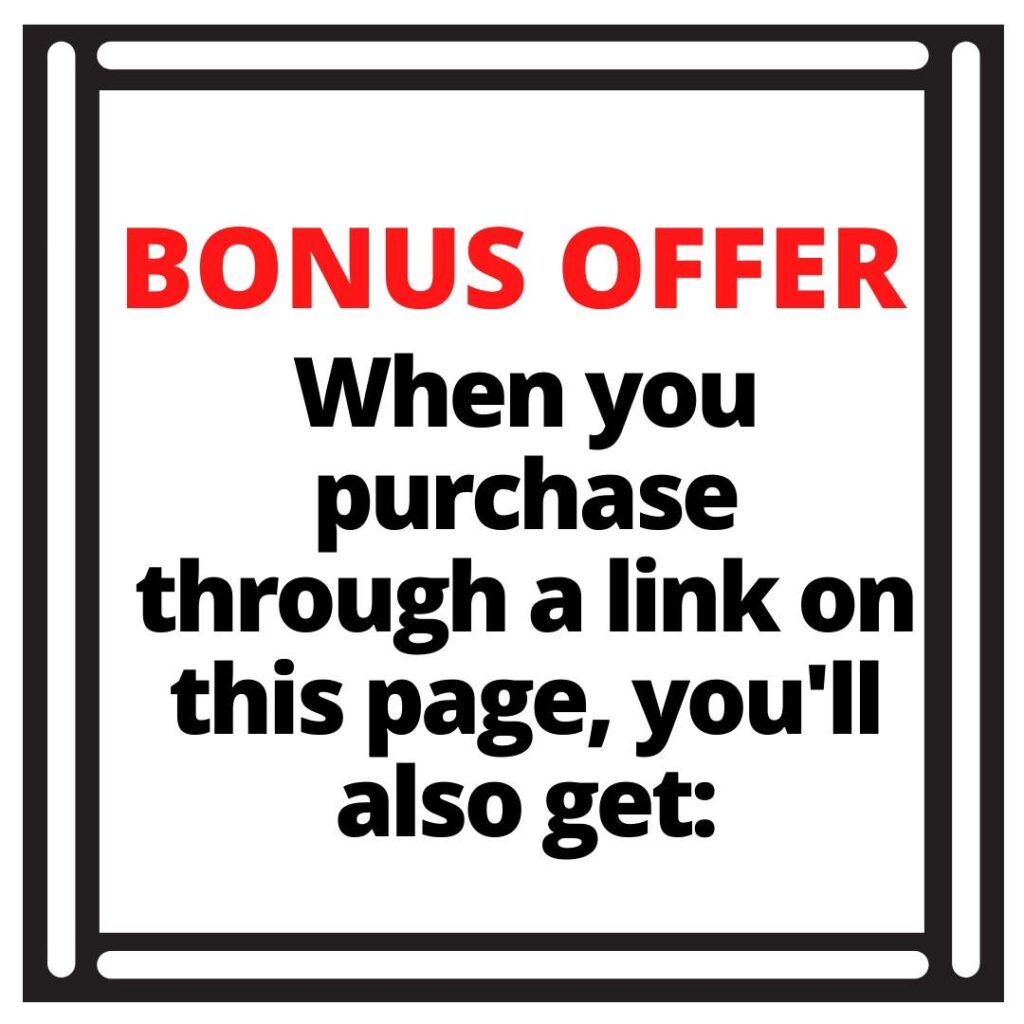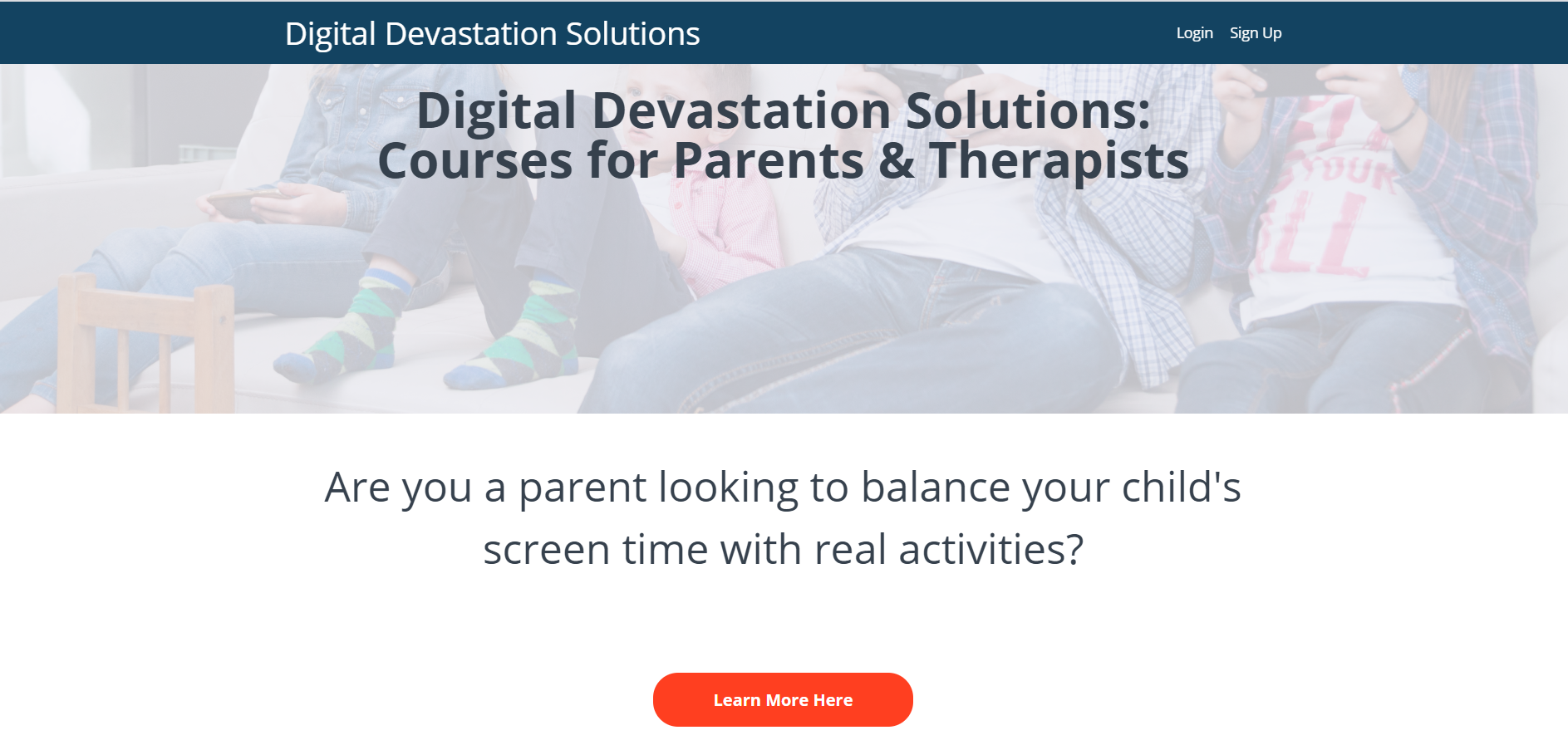Did you know there are specific symptoms of too much screen time that you’ve probably experienced? You’ve probably seen or experienced the symptoms of too much screen time. Blurry eyes, a muddled mind, difficulty with focus, trouble stopping the screens and behaviors when asked to stop…But what are others experiencing when it comes to screen time overload?
As a related resource, this screen time checklist can be helpful in assisting children and teens to complete a certain amount of non-screen tasks before getting access to their devices. Another comprehensive and powerful resource when it comes to screen time is this digital devastations course for therapists and parents.
Part of understanding the symptoms of screen time overload is getting on board with being a tech wise family. Just reading about these ideas and tips and getting to know the impact that technology time has on development is a great first step.
Symptoms of too much screen time
How do screens really impact our kids? And, exactly how much screen time is too much? Is it really that bad if our kids watch movies and play video games all summer? Today, I’m detailing all about what the research tells us about screens, and what evidence we have on the symptoms of screen use in children and teenagers.
Screen time symptoms include:
- headache
- blurry eyes
- foggy brain
- eye strain
- sleep issues
- tantrums
- emotional skills and emotional development
- issues with problem solving skills
- weight
- physical health
More common struggles are listed below when it comes to specific screen time symptoms.
This blog post is part of a short series I’m sharing on screens and the devastating impact that they have on our children. I’m very excited to share with you a powerful tool that we can use to make a positive change in our kids. One that can impact our community and our children’s futures.
We share some of the impact of screentime in our graphic below:
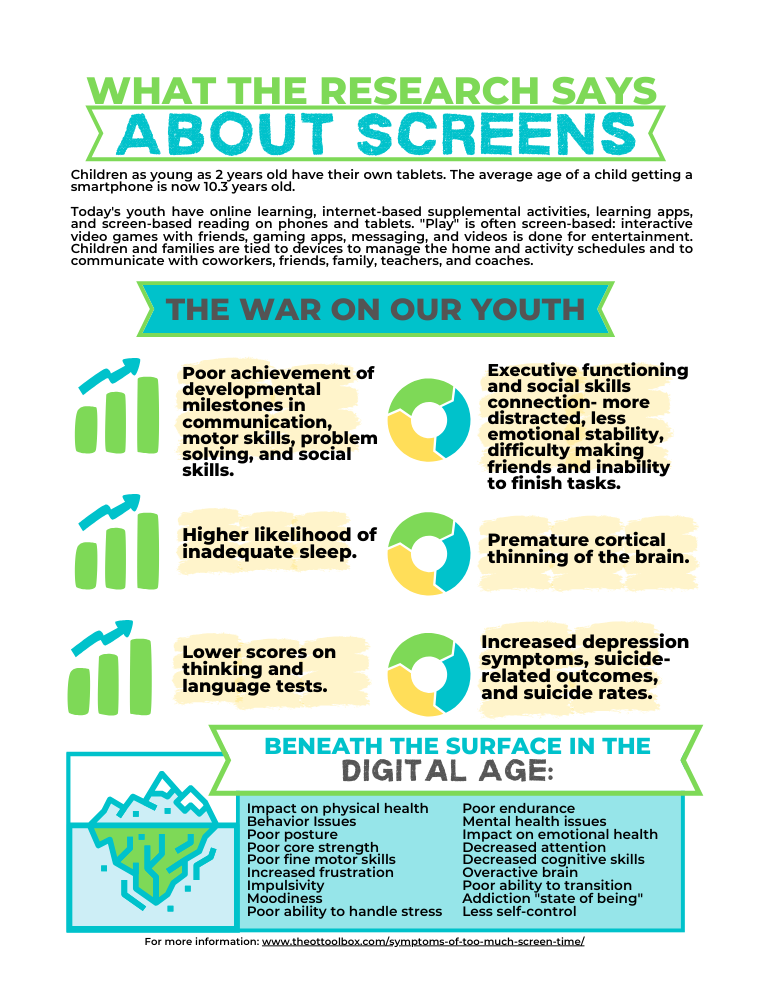
Average Screen Time
We know first hand that children today are using screens more and more. Whether it’s online learning, entertainment apps and games, watching videos, or playing with friends, screens are a part of our kids’ daily lives.
Unlike kids of just a few years ago, children today have online learning, internet-based supplemental activities, learning apps, and screen-based reading on phones and tablets.
With the sudden onset of distance learning and telehealth, kids are on screens, tablets, phones, and computers more now then ever before. Online classroom lessons and therapy sessions are just one more reason for more screen hours.
“Play” is often screen-based: interactive video games with friends, gaming apps, messaging, and videos is done for entertainment. Children and families are tied to devices to manage the home and activity schedules and to communicate with coworkers, friends, family, teachers, and coaches.
The Centers for Disease Control and Prevention (CDC) reports that children ages eight to 10 spend an average of six hours per day in front of a screen, kids ages 11 to 14 spend an average of nine hours per day in front of a screen, and youth ages 15 to 18 spend an average of seven-and-a-half hours per day in front of a screen.
According to the one study, children aged 8-18 spend and average of 7.5 hours in front of a screen for entertainment each day. That is a startling number!
But, when you think about requirements for distance learning, video entertainment, communicating with friends and family, app usage, that number begins to make sense. All of the screen time throughout the day and evening hours adds up quickly.
According to the World Health Organization, over 23% of adults and 80% of adolescents are not sufficiently physically active. Our kids are living sedentary lives and the adults in their lives are as well.
Children are spending more time in sedentary activity by using screens and less time in creative, active play that their bodies NEED to thrive and develop.
We also know that children under a certain age should not have access to screens. We know that kids need more active play and creative play that involves the senses. We know that our children need these things to regulate emotions, behaviors, and to give their nervous systems what they need to learn and develop.
We’ve talked a lot on this space about wellness and well-being. We’ve discussed the balance of occupations. But, have you ever looked deeply into the research on screens?
Children as young as 2 years old have their own tablets. The average age of a child getting a smartphone is now 10.3 years old. This is astounding and gravely against recommended ages of screen time according to the American Academy of Pediatric Guidelines.
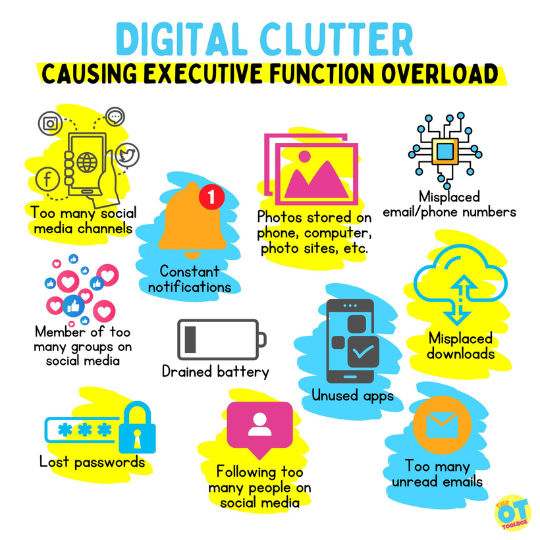

Digital Clutter
Digital clutter is a constantly growing mountain of distractions. And those distractions lead to MORE distractions…impulsivity, forgotten tasks, and lost time… digital clutter impacts executive functioning abilities in a huge way! Does this sound familiar or what??
Just because the clutter doesn’t take up physical space it’s easy to ignore but that doesn’t mean it doesn’t effect us, in a major way.
We have all wasted 15 minutes searching for a specific photo or an email. Then 10 minutes resetting a forgotten password. Felt that overwhelm by constantly dinging notifications.
Other examples of digital clutter include:
- Not deleting emails
- Too many unread emails
- Too many notifications on the phone
- Lost passwords
- Following too many people or pages on social media
- Having too many unnecessary social media accounts
- Being a member of too many social media groups (too many notifications)
- Drained battery on devices
- Misplaced downloads
- Unused apps
- Constant notifications on devices
- Photos stored on all devices and in random places
- Misplaced emails or phone numbers
You might recognize some aspects of this…
When you have all of this digital clutter, it causes another aspect of screen time issues: overwhelm and even anxiety. This is something that I think all of us have experienced as a result of screen distractions. We are trying to do a task like contact someone about something important. But we’ve misplaced the email or their phone number. Or we’ve downloaded a file to use in a therapy session, only to not recall where it’s downloaded to or which device it’s on.
This list could go on and on and on!
Here are some quick wins to chip away at the existing digital clutter. Set a timer and choose one!
- Put all of your downloads in once place. Use the same email address to download all of the resources.
- Look at all of the apps on your device and remove ones that you don’t use that often. It’s like cleaning out your closet; if you haven’t worn a piece o clothing in a year, donate it. The same goes for apps. If you haven’t used it recently, delete!
- Unsubscribe from emails + delete>> Set a timer and unsubscribe from any emails you don’t read. Delete any unneeded emails.
- Delete photos>>Take 5 minutes and scroll through some photos. Delete duplicates or blurry shots, anything you actually won’t really look at again.
- Organize apps>> Go through the apps on your phone and delete any that you haven’t used in the past year. Sort similar apps into folders on your screen. Just tap and drag them into a combined folder.
What are your best tips for managing the digital clutter overload?
More information on attention and organization are on our executive functioning skills resources.
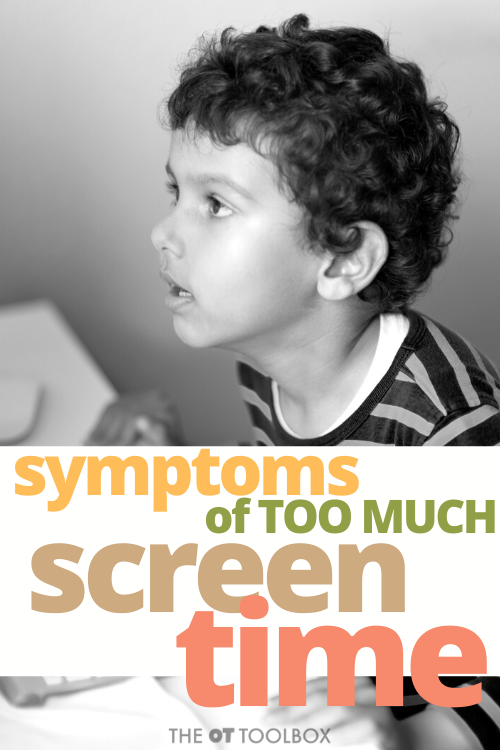

Too much screen time symptoms
The effects of screen time on children is showing up in the research. We are seeing astonishing symptoms of screen time in so many ways. These are just SOME of the symptoms and signs of screen overload:
- Impact on physical health
- Behavior Issues
- Poor posture
- Poor core strength
- Poor fine motor skills
- Increased frustration
- Impulsivity
- Moodiness
- Poor ability to handle stress
- Poor endurance
- Mental health issues
- Impact on emotional health
- Decreased attention
- Decreased cognitive skills
- Overactive brain
- Poor ability to transition
- Addiction “state of being”
- Less self-control
Do these screen time symptoms sound familiar? Some of them probably do! But, it’s not just something that is in your mind when it comes to screens and foggy thoughts.
Then, there can even be other symptoms of too much screen time that arise that we don’t always think about. For our kids who are developing in other areas, this can be a real problem.
This might include social withdrawal. We see the child that would rather watch YouTube videos than go outside and play with neighbors or friends.
Dysregulation
We might see emotional dysregulation. Particularly in children and adolescents, can be linked to emotional challenges, including increased irritability, frustration, or mood swings.
This leads us to our next issue…
Behavioral Issues
Still another area of consideration are the behavioral issues. You’ve probably seen the toddler or preschooler that is playing on a device. When the parent takes it away suddenly, there is a tantrum. This happens because a preferred activity is suddenly removed. The brain and body need to reset and a tantrum or breakdown results. There can be an increase in behavioral problems, including impulsivity, inattention, and hyperactivity, which might not be immediately attributed to screen time.
Cognitive Delays
For young children, especially toddlers and preschoolers, we might see cognitive delays. In young children, excessive screen time can impact cognitive development, potentially delaying language acquisition, attention span, and problem-solving skills.
Pencil Grasp
Pencil grasp and visual motor skills are another area you might not think about right away. Overreliance on screens may limit opportunities for engaging in activities that develop fine motor skills, such as drawing, writing, or manipulating small objects. Pencil grasp development requires play and when the primary form of play in young kids is via screens, we see that impact as school based therapy providers. This is one of the main things that therapists want parents to know about pencil grasp.
warning signs of too much screen time adults
The warning signs for too much time on screens isn’t just for kids. We see the impact of screentime in adults too.
Excessive screen time in adults can have various negative effects on physical and mental well-being. For adults, we might need to spend long hours on a computer while at work. Then to spend more hours at home as entertainment when watching shows on a small screen or while scrolling social media. All of this time adds up!
Do any of these sound familiar?
- Eye Strain: Complaints of dry, irritated, or tired eyes.
- Headaches: Frequent headaches, particularly tension headaches, may be linked to prolonged screen use.
- Insomnia: Difficulty falling asleep or staying asleep may be associated with excessive screen time, especially before bedtime.
- Sedentary Behavior: Excessive sitting or lack of physical activity associated with prolonged screen use.
- Posture Problems: Neck and back pain due to poor ergonomics or prolonged periods of screen use.
- Increased Stress: Excessive screen time, especially on social media or news sites, can contribute to heightened stress levels.
- Anxiety and Depression: Some individuals may experience increased symptoms of anxiety or depression related to their online activities.
- Reduced Productivity: Difficulty focusing or completing tasks due to distractions from screens.
- Memory Issues: Challenges with memory and cognitive functioning associated with prolonged screen use.
- Isolation: Spending excessive time on screens may lead to reduced face-to-face social interactions, potentially contributing to feelings of loneliness or isolation.
- Blurred Vision: Vision-related issues such as blurred vision or difficulty focusing.
- Digital Fatigue: Feeling mentally exhausted or drained after extended screen use.
- Work or Personal Neglect: Neglecting work responsibilities, personal relationships, or household duties due to excessive screen time.
- Strained Relationships: Increased conflicts or strained relationships with friends, family, or colleagues due to excessive screen use.
- Lack of Exercise: Reduced engagement in physical activities due to prolonged screen-related activities.
Screentime in adults
It’s important to note that these signs may vary among individuals, and some people may be more resilient to the effects of screen time. However, being aware of these warning signs can help individuals and healthcare professionals address potential issues related to excessive screen use and promote a healthier balance in daily activities.
Encouraging breaks, adopting proper ergonomics, and establishing screen time limits can contribute to a more balanced and sustainable approach to technology use.
These are the things we see when it comes to screen time. But what else is happening when screens take over the balance of play, physical activity, creative play, and imagination?
- Less family interaction
- More frustration
- More stress
- Poor ability to transition between tasks (stopping screen play and moving to a different task)
- Less creative play
- Less imagination play
- Less opportunities for communication and interaction
- Wanting more and more screen time
- Lack of energy
- Poor motivation
- More distracted
- Posture issues
- Difficulty with pinch and grip strength and dexterity
- Eye tracking and shift difficulties
The list could go on and on! It’s the iceberg theory of behaviors, only it’s applied to screen time and over use.
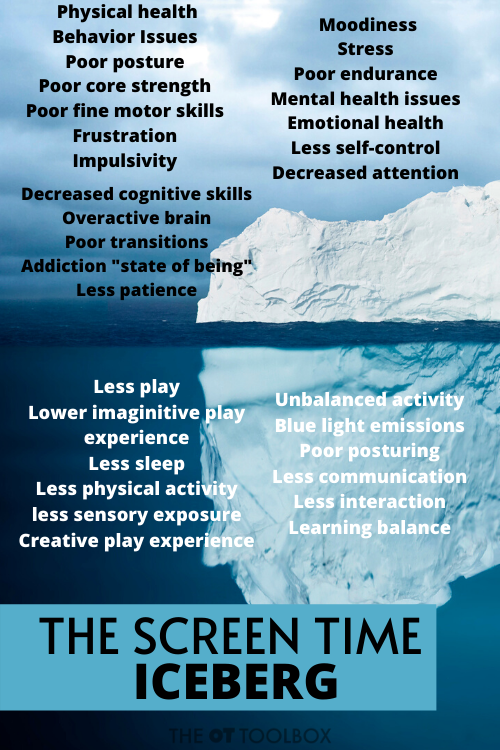

There is research behind these common concerns. More on that in an upcoming blog post.
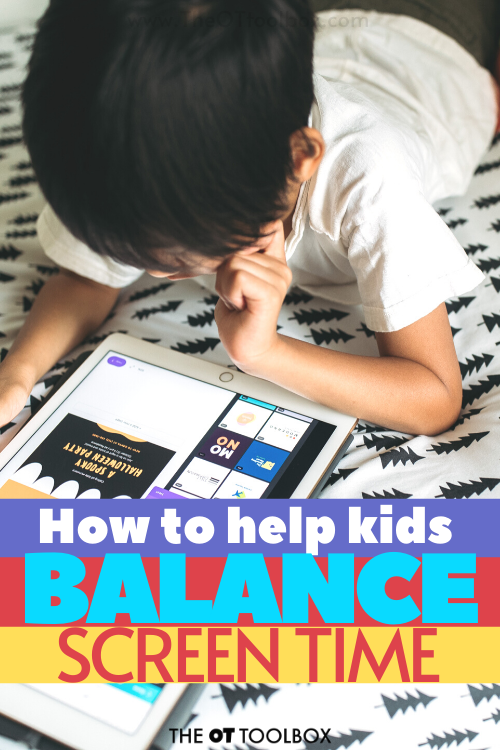

How to balance screen time
We can do something. We can make a difference in our children and our future.
This doesn’t mean that we need to completely take screens away from our kids! It doesn’t mean that they can’t watch videos or play games with friends online.
But, we can offer balance, and the activities their nervous systems need to empower sensory and regulation so learning, emotions, behaviors, and mental well-being flourishes. Much of this can be impacted by another aspect, the individuals co-regulation abilities.
What kids REALLY need, is balance. They need play to help develop their brains. They need play to create new neural connections in the brain. They need creative activities to build self-confidence, emotional well-being, and strategies to cope.
Wondering about how much screen time is too much, and what to do when the effects of screen time seem to impact daily life?
How much screen time is too much?
Determining how much screen time is “too much” depends on various factors, including age, developmental stage, and the content being consumed. It’s important to remember that moderation is key.
The fact is that current education, social interactions, entertainment, and daily life tasks all revolve around screen use. Because daily life requires use of screens, we can’t be made to feel guilty about using phones, tablets, laptops, and other types of screens. This is a change in daily life experiences and a piece of the puzzle that must be considered.
Let’s take a look at what current research says about moving from the moderation level to the “too much screen time” level.
The American Academy of Pediatrics (AAP) provides guidelines regarding screen time for children and adolescents:
- For Children Under 18 Months: The AAP recommends avoiding the use of screen media other than video chatting.
- For Children 18 to 24 Months: If introduced, parents should choose high-quality programming and watch it with their children to help them understand what they are seeing.
- For Children Ages 2 to 5 Years: Limit screen time to one hour per day of high-quality programming, and co-view media with children to help them understand what they are seeing.
- For Children Ages 6 Years and Older: Place consistent limits on screen time, ensuring it does not interfere with adequate sleep, physical activity, and other behaviors essential to health.
While we can’t change current screen usage as times change; students work from personal tablets all day at school; shopping over apps is more and more common; checking in to the doctor’s appointment is done via a tablet at the doctor’s office door.
What we can do is be sure that activities such as physical play, face-to-face interaction, and sufficient sleep are integrated within the day over screen time.
Excessive screen time has been associated with various negative outcomes, including poor sleep, obesity, and delayed language development in young children. However, it’s essential to recognize that not all screen time is equal. Educational content and interactive apps can have benefits when used appropriately and in moderation.
As an occupational therapy practitioner, you can work with families to create a balanced approach to screen time that takes into account individual needs and developmental considerations. Encouraging parents to engage in activities that promote social interaction, physical activity, and creative play can help mitigate the potential negative effects of excessive screen time.
For more information, you can refer to the American Academy of Pediatrics guidelines on media use for children and adolescents.
How to manage Screen time
There is a way to combat the requirements of online learning, distance schooling, social distancing, and the newest concerns of today. One way to do this is by taking a multisensory approach to academics.
We can balance digital entertainment with the tools that kids need to flourish in emotional, mental, and physical well-being.
One way to manage screen time is to focus on telling time and time management in kids.
We can manage screen time in ways that make a true difference.
Resources for Reducing Screen time
To support kids and the families that are looking for ways to adjust to the influx of screentime we have these days, here are some resources you can offer as a therapy provider:
- Occupational Therapy Play
- Baby learning and play ideas
- Toddler learning and play ideas
- Kindergarten learning and play ideas
- First Grade learning and play
- Second Grade learning and play
- Middle School occupational therapy activities
- High School occupational therapy activities
Too much screen time can have devastating impact on kids and adults. We see this every day. Hopefully, the information in this blog post can help with understanding about the effects of too much screen time in kids and in adults.



Colleen Beck, OTR/L has been an occupational therapist since 2000, working in school-based, hand therapy, outpatient peds, EI, and SNF. Colleen created The OT Toolbox to inspire therapists, teachers, and parents with easy and fun tools to help children thrive. Read her story about going from an OT making $3/hour (after paying for kids’ childcare) to a full-time OT resource creator for millions of readers. Want to collaborate? Send an email to contact@theottoolbox.com.



